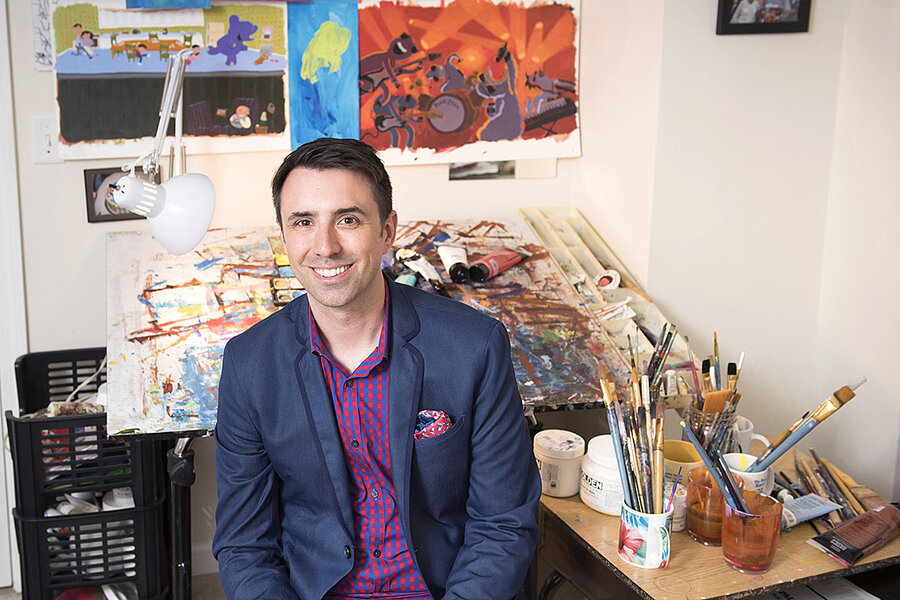How author Jarrett Krosoczka illustrates gratitude – on the page and in life
Loading...
| Boston
Jarrett Krosoczka, unshaven and unnerved, paced the floor of his kitchen in western Massachusetts. As a children’s book author, he knew how to tell stories. But as a last-minute substitute that Friday afternoon six years ago, Mr. Krosoczka only had four hours to craft a TEDx Talk.
His wife, Gina, knew immediately what he should speak about: his upbringing as the son of a mother addicted to heroin. “Be honest and be transparent,” he recalls her saying.
Now, with his first book for young adults, an illustrated autobiography, he takes that edict to heart once more.
Why We Wrote This
Jarrett Krosoczka’s recent memoir is about growing up with a parent struggling with addiction. But its messages for young people focus on resiliency and giving thanks.
In “Hey, Kiddo,” Krosoczka celebrates his grandparents, who made the choice to raise him as their own son as his mother struggled with addiction. In the memoir, a National Book Award finalist, he brings to life his upbringing with a muted ink palette featuring only flashes of burnt orange – the color of one of his late grandfather’s pocket squares that now serves as a safety blanket for one of Krosoczka’s daughters.
“I wouldn’t change a single thing about my childhood because it made me who I am,” he says in a phone interview. “My mother’s [artistic] talent and incarceration made me want to do something big with my artwork.... I’m grateful for everything that’s led me up to this point.”
From writing his memoir to starting a national lunch lady appreciation day (one of his series features a crime-fighting cafeteria worker), the author regularly makes the case for gratitude: A thank-you reminds both giver and receiver of their importance and connection to others.
“A thank-you can change a life,” Krosoczka (pronounced Crow-sauce-KA) said in his second TED Talk. “It changes the life of the person who receives it, and it changes the life of the person who expresses it.”
And at a recent event at the Boston Athenaeum, he took the opportunity to show his gratitude to another writer who helped him along his way.
‘Nice cat’
In 1986, children’s book author Jack Gantos visited Krosoczka’s third grade class at Gates Lane Elementary School in Worcester, Mass.
He went room to room, assigning the first task he could think of: Draw his character Rotten Ralph. He patrolled the aisles between the desks. Krosoczka had drawn the best one. “Nice cat,” Mr. Gantos told him. Krosoczka writes about the encounter in his memoir, depicting his third-grade self as swelling with pride.
On a Saturday in November, Krosoczka invited Gantos – who won the Newbery Award for children’s literature for “Dead End in Norvelt” – to talk about art and their friendship. At the end, he presented Gantos with a painting of Rotten Ralph.
“It was kind of a thank-you from him,” Gantos says in a phone interview. “And I’m very grateful that he mentioned me. It reminds me to always say that to every kid that has any kind of talent or sometimes even a good-looking stick figure.”
Gantos’s bright red “very very nasty cat” and Krosoczka’s bright yellow Lunch Lady now stand side by side in a mural honoring Massachusetts children’s book authors at Boston’s Logan Airport.
Both Gantos and Krosoczka individually travel across the country talking to students about art and writing. These visits convinced Krosoczka that not only did he want to write his memoir, but he needed to write it.
“Every school I went to – it didn’t matter what town, what city, what state – I would talk to the teachers and they would say, ‘We have kids here who are just like you,’ ” he told the audience at the Athenaeum, one of the oldest independent libraries in the United States. “They have an incarcerated parent. They have an addicted parent. They’re being raised by an uncle, an aunt, or a grandparent. It wouldn’t matter if the school was 99 percent free and reduced lunch or it was a $30,000-a-year private school,” he says.
‘Hey, Kiddo’
Krosoczka knew “Hey, Kiddo,” his 38th book in 17 years, would be a big shift. He worried what readers and his family would think. After all, his grandparents “cursed like truckers who used to be sailors,” he says at the Boston event.
The memoir, which was a finalist for the National Book Award, is cropping up on end of the year “best of” lists. And while the top honor went to Elizabeth Acevedo for her novel “The Poet X,” Krosoczka says being a finalist – and the accompanying sticker – will help the book reach a wider audience, including kids struggling with the same issues.
At a recent reading, he noticed a very young boy in the audience. At first he wondered if the boy might be too young for the content (which is labeled 12 and up) but resisted saying anything because the boy and the adult he was with sat with such intention. While signing the boy’s book, he learned that the 8-year-old’s brother, who was 12, had recently died of an overdose.
“It’s each caretaker’s decision” what books their children read, he says. “But they should make that decision knowing that my mother started using when she was 13 years old.... Having these difficult conversations in the safe space of a book before the child has to deal with it in real life is really important.”
‘That is who I am’
On a school visit to his old elementary school in 2001, Krosoczka ran into his former lunch lady, Jeanie. That encounter sparked the idea for his crime-fighting Lunch Lady character (her catchphrase: “Justice is served”) and School Lunch Hero Day, a national day of appreciation started in 2012.
To show their gratitude to the men and women who feed them, some kids draw their lunch ladies as superheroes. One class made a hamburger of thank-you notes. Another made a thank-you pizza.
“Gratitude just permeates my work because that is who I am,” Krosoczka explains, adding, “Authors really are their works.”
Seeing an author model gratitude can be powerful for young people, especially if they lack models in their lives, says Jeffrey Froh, a Hofstra University professor who studies positive psychology.
“Gratitude strengthens your relationships – that’s the bottom line. It’s like social crazy glue,” he explains.
Countless caretakers tell Krosoczka that the Lunch Lady books made their kids want to read, he says. (He always uses the word caretakers rather than parents – a choice made with kids like him in mind.)
“Some people just get it with kids, and he’s one of them; he’s not preachy,” says Marianne Stanton, a librarian at the Melrose Public Library in Massachusetts who attended his Boston talk.
Krosoczka says he also benefited from adults who understood young people. An important moment in his book – and life – features Mark Lynch, who taught the author comics and animation as a teenager at the Worcester Art Museum. Mr. Lynch says in an interview that Krosoczka captured the truth of their relationship in the book, “even my gestures.”
Hearing from Krosoczka “is the thing that you live for as a teacher,” says Lynch, adding, “It reminds you of the awesome responsibility of teaching.”
Whatever Krosoczka writes next, Lynch says, he knows the author will make the 65-mile trek to Worcester – as Krosoczka has done once a year for the past 17 – to be a guest on Lynch’s radio show. He will, as he’s always done, go out of his way to make time for his former teacher.






